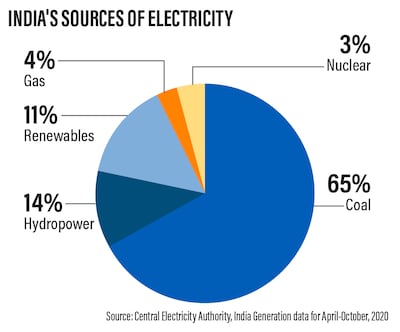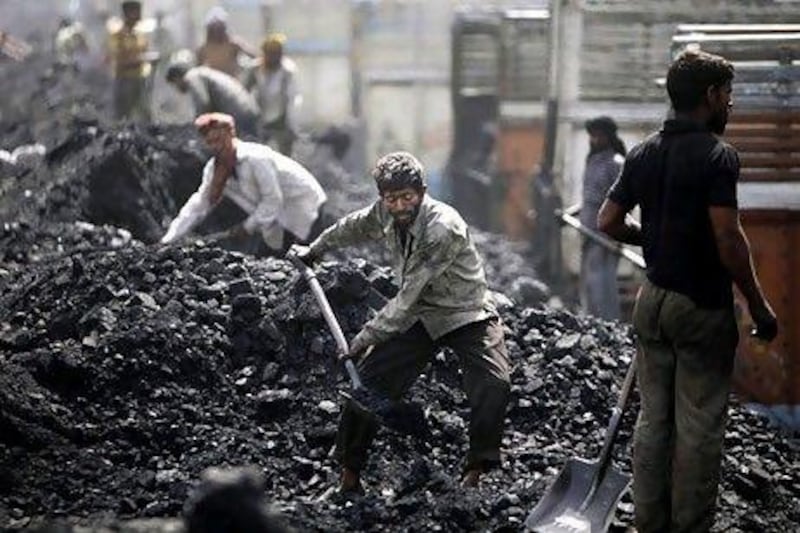India is trying for a greener future, pushing to add more renewable sources into its energy mix. However, the country's enormous dependence on coal to meet its growing energy needs is not likely to end anytime soon.
While Asia's third-largest economy gradually climbs the ladder of clean energy over the next few decades, policymakers in New Delhi in the meantime need to find more efficient ways of using of coal to generate power.
“Given that India will continue to rely on coal power in the coming decade, it must rein in the wasteful use of coal and improve generation efficiency,” Karthik Ganesan, director of research co-ordination at the Council on Energy, Environment and Water (CEEW), a Delhi-based policy research institute, says.
Coal-based power accounts for about 65 per cent of total electricity generated in India. The country, however, aims to grow the ratio of renewables in its energy mix as it targets 450 gigawatts of clean energy by 2030. India is betting on solar power to lead the push for green energy as it tries to meet its commitment to reduce its carbon footprint and sate the growing appetite for power over the coming decades.
India is the third-largest emitter of greenhouse gases in the world and coal is a major contributor to its carbon footprint. But under the Paris climate change agreement, it has committed to cut its emissions as a percentage of its gross domestic product by 33 to 35 per cent by 2030 from 2005 levels.
Coal will continue to play a vital role in fuelling the country's economy despite the fossil fuel's harmful impact on the climate, analysts say. The International Energy Agency forecasts that India is expected to account for the largest share of energy demand growth over the next two decades, with its energy consumption almost doubling to meet the needs of an expanding economy and urbanisation.
“Renewable energy technologies are still developing and issues of intermittency and storage are still being resolved,” Vinaya Varma, managing director and chief executive of mjunction services, an e-commerce platform that provides online coal sales services in India, says.
“Unless renewable energy becomes a source of stable and base-load power through proven and economical technologies, coal will continue to play a key role in India's energy sector.”
It will be a long process for India to wean itself off coal, partly because many stakeholders depend on revenue from the industry.
State-run Coal India “alone accounts for over 85 per cent of total coal production in India and it has already set an ambitious target to increase production in subsequent years”, says Binod Modi, head of strategy at Reliance Securities, a Mumbai-based broking house.
“Rich coal reserves in various areas of the country offer huge employment [opportunities] ... also ensure hefty taxes for the government and sizeable business for railways,” he says. “Considering these facts, we believe coal is unlikely to be phased out [soon].”
Another challenge for India is the inefficiency of its coal industry and the financial distress of its power sector. Despite having some of the largest coal reserves in the world, India is a net importer of the fossil fuel.
“We believe land acquisition issues, the lack of adequate technology and transparency [issues] in allocation process have been key concerns for the industry over the past years,” says Mr Modi.
The country's coal industry “is facing major pressures as a result of a changing market and policy context, as well as near‐term challenges related to Covid‐19”, the IEA said in its India Energy Outlook 2021 report.
“In the face of these pressures, coal [industry] needs to switch to a much leaner, more cost‐efficient model for operation and investment,” the IEA added.
Measures to boost efficiency could include improving the operational performance of mines and plants, streamlining logistics and bringing in more private sector investment – something that India is already working towards, it adds.
While several countries are looking to reduce their use of coal − including Germany, which aims to phase out coal as an energy source from its power mix – India this year launched its largest-ever auctions of coal mines. This is part of government plans to open up the industry to allow the private sector to play a larger role in coal mining, allowing winning bidders to produce and sell the fuel. The ultimate aim is for India to become a net exporter of the fossil fuel.
“[The] opening of coal sector for commercial mining was a fantastic move to improve productivity in the sector,” says Reliance Securities' Mr Modi. “This should essentially aid India to reduce its import dependence in the long run.”
However, India received no bids in July for 48 of the 67 mines it had put up for auction, with investor interest dampened by environmental concerns and low margins.
Improving efficiency becomes all the more pressing as India's coal industry has been impacted by the Covid-19 pandemic that has affected demand for power. This resulted in Coal India reporting a 23.9 per cent decline in its net profit for the financial year ending in March, compared to the previous fiscal year.
However, despite weaker demand, production remains on an upward trajectory. India's coal production is set to increase to 827.8 million tonnes this year from 777m tonnes in 2020, analytics firm GlobalData said in a report in June.
GlobaData describes this as “an impressive feat given the operational disruption caused by Covid-19”, adding that “a key to this increase in output is the entry of private players to the industry”.
The recent deadly second wave of coronavirus infections in India has also posed some short-term challenges to the industry.
“The sharp increase in new Covid-19 cases since the beginning of March 2021 and fresh lockdowns across key coal-producing states – such as Odisha, Chhattisgarh, Madhya Pradesh, Maharashtra and Telangana – has hampered India’s coal operations,” says Vinneth Bajaj, a mining analyst at GlobalData.
Experts say that slower-than-expected growth of demand for power in India has exacerbated the under-utilisation of the country's coal assets.
According to a new study by CEEW, India has an opportunity to save $1.23 billion each year if it shuts down some of its old coal-fired power plants – which consume more fuel than modern facilities – and runs the newer ones for longer periods of time.
The study recommends considering 30 gigawatts of India's coal-based capacity for accelerated closure.
“Decommissioning a part of the fleet today could make coal power generation more efficient and less polluting, and accelerate decarbonisation in the power sector,” says Mr Ganesan. “Decommissioning identified assets will usher in new investments in a more balanced generation system that does not have the sword of surplus hanging over it.”

The new system proposed by CEEW would avoid burning 42m tonnes of coal a year, according to the study. It adds that closing older, inefficient plants would also result in a one-time saving of $1.37bn, which would have been required for pollution control retrofits.
While coal may not be phased out in the near term, experts say that the share of coal in the energy mix will reduce over time.
“India has not adopted any strategy to phase out coal within a timeline,” says Mr Varma.
The country is increasing its share of renewable energy and several energy companies in India, including Tata Power and state-owned NTPC, have announced plans not to invest in any new greenfield coal-fired power plants.
“With the capacity of renewable energy growing fast and marginal addition to coal-fired power plant capacity, the share of coal in the country's energy mix would be coming down progressively in the years to come,” says Mr Varma.






